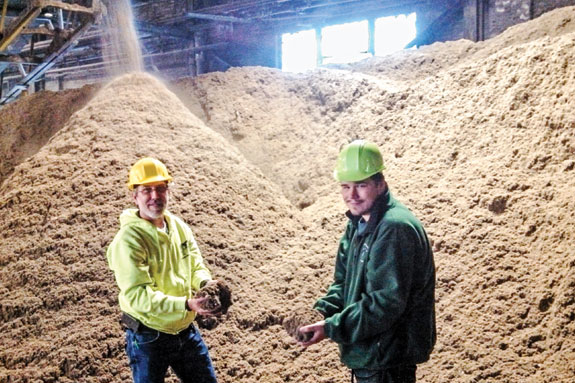Though recycled dairy cow bedding has been cycling throughout farms in the greater New York state area for more than 15 years, depending on who you talk to, word is still getting out about the “green” bedding and its benefits.
In the case of one recycled bedding manufacturer in New York – which makes bedding from the sludge residue of paper manufacturing such as recycled cardboard – at least so far, competition for the product has been limited if existent at all, according to company officials.
Joe Elston, manager at Syracuse Fiber Recycling in Syracuse, New York, says that for many years (since the late ’90s), Syracuse Fiber Recycling was reportedly the only one in New York providing recycled bedding to dairy cow producers.
However, the grapevine has it that just this summer a new company in the Buffalo area may be offering a similar product.
“Otherwise, to the best of our knowledge, nobody’s done exactly what we’re doing in this part of the country for the last 15 or so years,” Elston says.
That said, Frank Welcome, DVM, senior extension associate of Cornell University’s Central Laboratory in Ithaca, New York, says paper products and byproducts can be very effective sources for dairy cattle bedding.
And he suggests that there are other sources of paper-based bedding in New York but notes that Syracuse Fiber has been around the longest and maintains a fairly consistent supply for customers.
In first getting the company off the ground, Elston of Syracuse Fiber Recycling says his father’s connections were instrumental.
“What helps is that our father has a background in dairy farming. He already knew people in the paper mill business. Putting two and two together, he came up with the recycled cow bedding concept.”
The concept is the result of an ever-increasing push toward recycling and being green.
“It seems to have been good timing to offer such a product,” Elston says.

Joe’s father, Roger, started the business in 1997-1998 after working on a dairy farm in northwest Ohio for a number of years.
(Joe’s brother, Roger, general manager, also is a nine-year veteran of the company).
Today, the customer base is a solid 70-plus strong. Most customers are New York-based.
One of the oldest customers is Hi Hope Farm in Ellisburg, New York, of which Terese Bibbins is manager.
“Fifteen years ago, we went on board to help them and see how it would work. We were one of the first to use the recycled bedding in this area. We have stuck with them because the cows do well with it,” Bibbins says.
“Often people will come and they ask us what we use; they are surprised and ask for information,” she says of the bedding which, while comparable with other bedding, is also competitive in price.
“Any heifer barns we have built, we’ve built with using paper sludge for bedding in mind,” she adds.
Her selling points to farms on the fence: availability, communication with the guys at the plant, trucking and comfort of the cows.
“We’ve had instances where they’re so comfortable, they’re sleeping and we’re checking to make sure they’re OK. Cow comfort seems to work well. Lastly, the bedding is easy to use … and biodegradable,” she says.
A downside to the product can be its initial wetness. Welcome says Syracuse Fiber’s product is a byproduct of paper manufacturing and is often a wet material, which “can be a problem.
They do add material to the sludge to assist in drying and retard microbial growth, which appears to extend the useful life of the product.”
Though not promoting one bedding type over others, Welcome says the cost of bedding can be a selling point for places such as Syracuse Fiber Recycling.
“Waste paper is relatively inexpensive, especially with required recycling of paper as a component of overall waste reduction. It is clean, relatively dust-free and absorbent and makes sense as a bedding material,” he says.
“The use of paper as a bedding material can be very cost-effective. It largely depends on the cost of the material, cost associated with storage and processing (chopping into smaller particles). Sometimes the material is free.”
In naming other factors to consider regarding recycled bedding, Welcome notes: “The benefits can be dependent on the cost and availability of the paper products. Some paper materials may not be compatible with certain types of manure-handling systems.
The material also has to be dry, so having adequate storage away from weather is necessary.
When wet, the material can increase the risk for certain types of mastitis pathogens such as Streptococcal species and Klebsiella species. Particle size may be important for retention of the material in the stalls,” he says.
Other sources of paper used for bedding, according to Welcome, come from paper shredding.
“Some companies shred paper (including cancelled bank checks) and sell the material to farms in bulk and bales for bedding. Several area farms that use this material often mix it with sawdust or wood shavings.
It is very comfortable (added cushion effect) and absorbent; it is also retained in the stalls better than paper or sawdust alone,” Welcome explains.
He mentions shredded cardboard as another bedding option that appears to work well as animal bedding, though it needs to be kept dry and can be dusty.
“Periodically, the supply of waste paper is greater than the ability of the recycling industry to consume it.
Farmers can buy newsprint and other paper materials in the form of large bales, but this material has to pass through some sort of shredder or chopper to reduce the particle size and compaction in the stalls or bedded area,” he says. PD
Skernivitz is a freelance writer based in Berea, Ohio.
PHOTO
Joe Elston, left, and his brother, Roger, show the bedding product they sell mainly to New York dairymen. Photo courtesy of Joe Elston.





